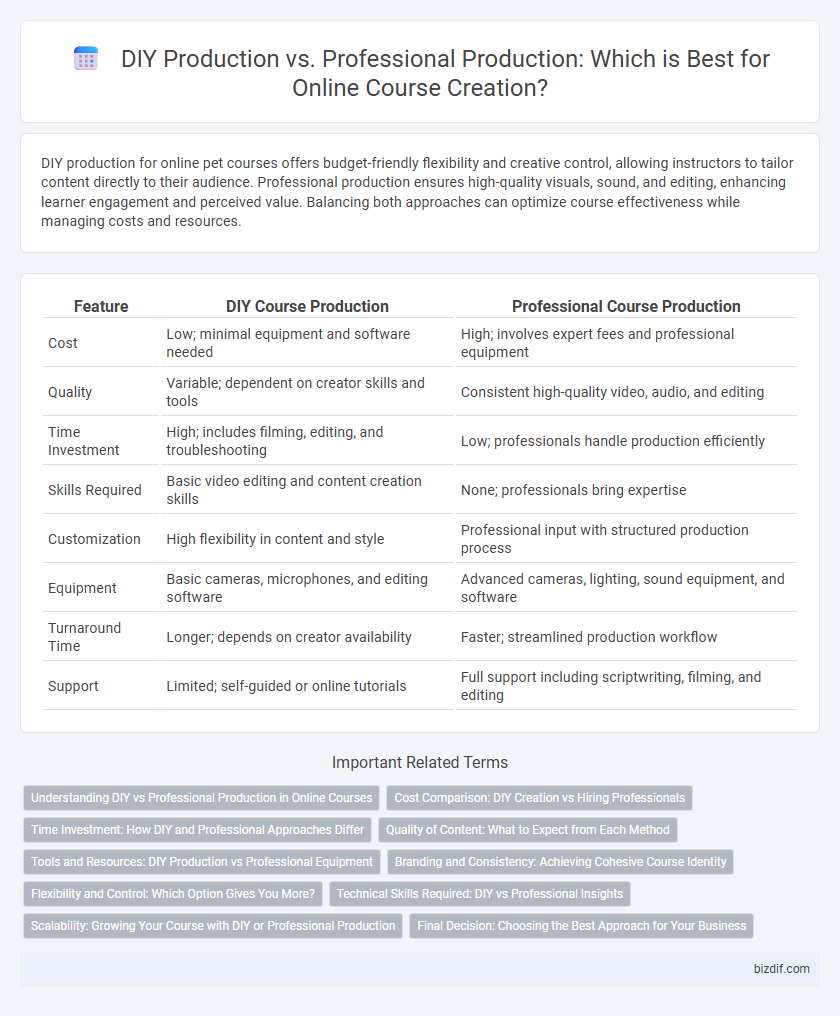DIY production for online pet courses offers budget-friendly flexibility and creative control, allowing instructors to tailor content directly to their audience. Professional production ensures high-quality visuals, sound, and editing, enhancing learner engagement and perceived value. Balancing both approaches can optimize course effectiveness while managing costs and resources.
Table of Comparison
| Feature | DIY Course Production | Professional Course Production |
|---|---|---|
| Cost | Low; minimal equipment and software needed | High; involves expert fees and professional equipment |
| Quality | Variable; dependent on creator skills and tools | Consistent high-quality video, audio, and editing |
| Time Investment | High; includes filming, editing, and troubleshooting | Low; professionals handle production efficiently |
| Skills Required | Basic video editing and content creation skills | None; professionals bring expertise |
| Customization | High flexibility in content and style | Professional input with structured production process |
| Equipment | Basic cameras, microphones, and editing software | Advanced cameras, lighting, sound equipment, and software |
| Turnaround Time | Longer; depends on creator availability | Faster; streamlined production workflow |
| Support | Limited; self-guided or online tutorials | Full support including scriptwriting, filming, and editing |
Understanding DIY vs Professional Production in Online Courses
DIY production in online courses offers affordability and creative control, allowing instructors to quickly develop content with basic equipment and software. Professional production provides polished visuals, expert editing, and high-quality audio, enhancing learner engagement and perceived course value. Balancing DIY and professional elements depends on budget, expertise, and long-term course goals to maximize educational impact.
Cost Comparison: DIY Creation vs Hiring Professionals
DIY online course production typically incurs lower upfront costs, with expenses primarily for equipment like microphones, cameras, and editing software, often totaling under $1,000. Hiring professional production teams can range from $5,000 to $20,000 or more, covering scriptwriting, filming, editing, and graphic design, ensuring higher quality but significantly increasing the budget. Evaluating cost-effectiveness involves balancing initial investment against potential revenue, course quality, and time spent on production tasks.
Time Investment: How DIY and Professional Approaches Differ
DIY online course production demands substantial time investment in planning, filming, editing, and troubleshooting, often extending project timelines significantly. Professional production teams streamline these processes through specialized expertise and efficient workflows, reducing overall time commitment for course creators. This efficiency in professional production enables faster course launches and more consistent quality control.
Quality of Content: What to Expect from Each Method
DIY production offers flexibility and cost savings but often results in variable audio-visual quality, which can affect learner engagement and content clarity. Professional production ensures high-quality visuals, crisp audio, and polished editing, elevating the overall instructional experience and boosting credibility. Investing in professional services typically leads to superior content delivery and increased course completion rates.
Tools and Resources: DIY Production vs Professional Equipment
DIY production for online courses often relies on affordable, user-friendly tools such as smartphones, basic microphones, and free editing software like DaVinci Resolve or Shotcut, enabling creators to produce content independently without extensive technical knowledge. Professional production utilizes high-end equipment including DSLR or mirrorless cameras, directional microphones, studio lighting, and advanced editing suites like Adobe Premiere Pro or Final Cut Pro, resulting in superior video and audio quality. Access to professional-grade resources significantly enhances course credibility and learner engagement through polished presentations and consistent audiovisual standards.
Branding and Consistency: Achieving Cohesive Course Identity
DIY production can hinder branding efforts due to inconsistent visual and audio quality, which may confuse learners and dilute course identity. Professional production ensures uniformity in design elements, sound clarity, and presentation style, reinforcing a strong, cohesive brand image. Consistent branding across all course materials enhances learner trust and strengthens brand recognition in competitive online education markets.
Flexibility and Control: Which Option Gives You More?
DIY production offers unmatched flexibility, allowing course creators to adjust content and pacing instantly without relying on external schedules. Professional production provides high-quality output but often involves strict timelines and less creative control, limiting spontaneous changes. For those prioritizing control over every aspect of their online course, DIY production emerges as the superior choice.
Technical Skills Required: DIY vs Professional Insights
DIY online course production demands basic technical skills such as video recording, audio editing, and slideshow creation, often utilizing user-friendly tools like Canva, iMovie, or Audacity. Professional production requires advanced expertise in lighting, sound engineering, multi-camera setups, and post-production software like Adobe Premiere Pro or Final Cut Pro to ensure high-quality content delivery. Understanding these technical skill differences helps educators decide between cost-effective DIY methods and investing in professional services for polished, engaging courses.
Scalability: Growing Your Course with DIY or Professional Production
DIY production offers cost-effective scalability for online courses by allowing creators to quickly update content and experiment with formats without large investments. Professional production enhances scalability through high-quality visuals and polished editing that attract larger audiences and foster brand credibility. Combining DIY flexibility with professional expertise can optimize course growth and sustain long-term learner engagement.
Final Decision: Choosing the Best Approach for Your Business
Selecting between DIY production and professional production depends on your budget, skill level, and desired quality for your online course. DIY production offers cost savings and creative control but may lack advanced technical polish, while professional production ensures high-quality visuals and sound that can enhance learner engagement. Evaluating your business goals and audience expectations will guide the final decision to deliver a compelling and effective course.
DIY production vs Professional production Infographic

 bizdif.com
bizdif.com